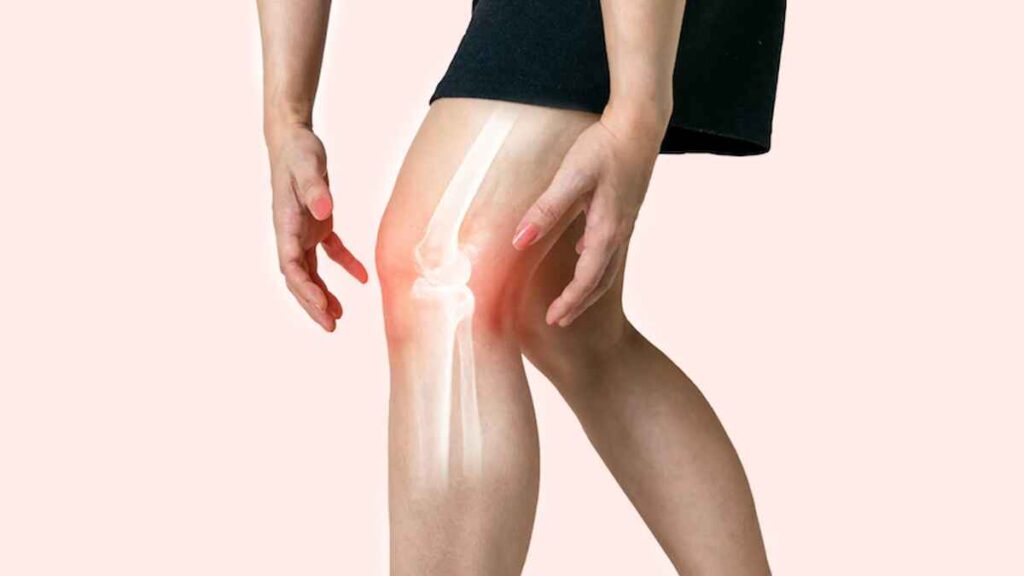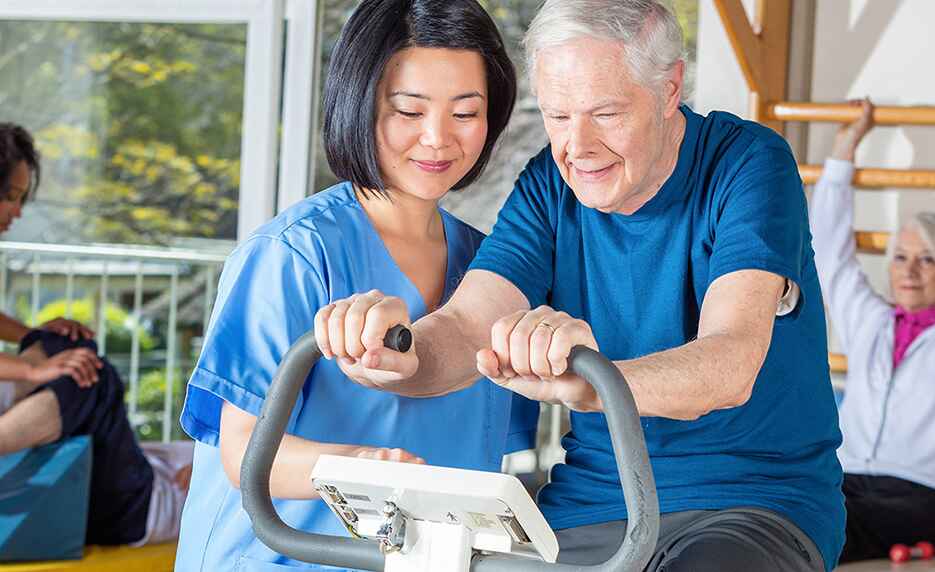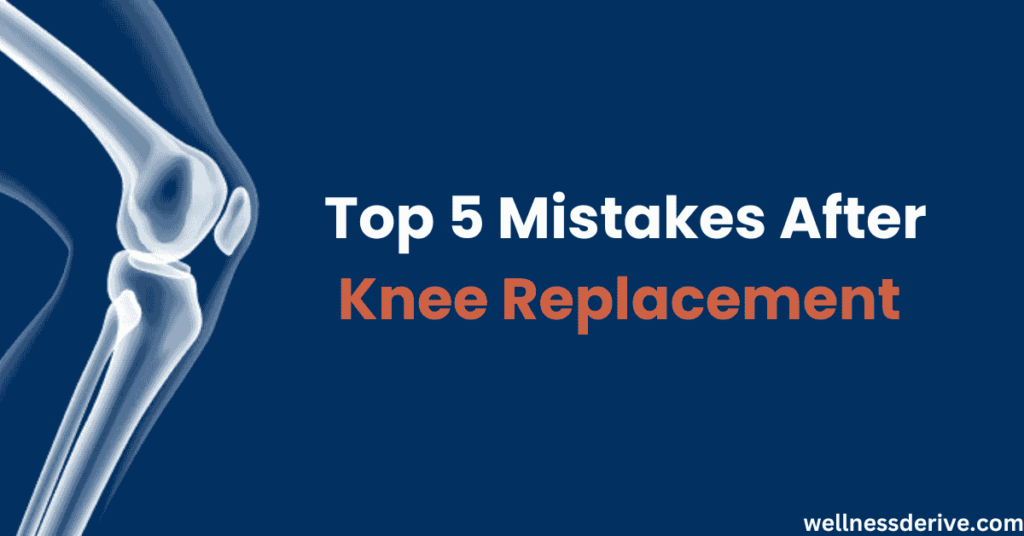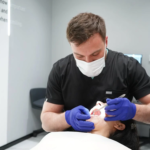Knee replacement surgery is a major step toward restoring mobility and improving quality of life. However, what happens after the operation is just as important as the procedure itself. Many patients unknowingly make post-surgery mistakes that delay healing, cause complications, or even affect the long-term success of their knee replacement.
In this guide, we’ll cover the top 5 mistakes after knee replacement, why they matter, and how to avoid them. Whether you’re recovering from total knee replacement (TKR) or preparing for one, these insights can help ensure a smoother, safer recovery.
Understanding Knee Replacement Recovery
Total knee replacement involves replacing damaged knee joint surfaces with artificial components, offering relief from arthritis or injury. Recovery typically spans 6–12 weeks for basic mobility, with full healing taking up to a year. Common challenges include swelling after knee surgery, fatigue after total knee replacement, and discomfort, particularly in the worst days after knee replacement. Understanding these challenges helps you avoid mistakes that could lead to complications like knee replacement gone wrong or prolonged post knee replacement swelling.
Why Avoiding Mistakes Matters
Mistakes during recovery, such as ignoring redness after knee replacement or overexertion, can delay healing or cause serious issues like swollen leg after knee replacement or infection. By learning what not to do after knee replacement, you can minimize risks and optimize your recovery, addressing questions like when should I worry about swelling after knee surgery?
Mistake #1: Overdoing Physical Activity Too Soon

Many patients feel excited about getting back to normal life and may push themselves too hard too early. While movement is essential after knee replacement, doing too much too soon can backfire.
Why It’s a Mistake:
- Swelling after TKR is common, but aggressive activity can make it worse.
- Overexertion increases pain and delays healing.
- It may even cause damage to the prosthetic joint or surrounding tissues.
Common Signs of Overdoing It:
- Excessive swelling in the leg after knee surgery
- Persistent fatigue after knee replacement
- Pain in calf after knee replacement
What to Do Instead:
- Follow a gradual rehab plan.
- Prioritize rest as much as exercise.
- Listen to your body—pain and swelling are warning signs.
Mistake #2: Ignoring Persistent Swelling or Pain

While some swelling and discomfort are normal, ignoring persistent symptoms can lead to complications.
Why It’s a Problem:
- Swelling or pain that doesn’t subside could indicate issues like infection, blood clots, or joint misalignment.
- Leg swelling after knee surgery or redness could also be warning signs of deeper problems.
Red Flags to Watch For:
- Severe swelling that doesn’t improve with rest or icing.
- Redness after knee replacement or heat around the joint.
- Calf pain after knee replacement, which could indicate a blood clot.
How to Avoid It:
- Regularly monitor your knee and surrounding areas for unusual changes.
- Consult your doctor immediately if swelling persists or worsens.
- Use ice packs and keep your leg elevated to reduce swelling.
Mistake #3: Skipping Physical Therapy

Physical therapy is an essential part of recovery, yet some patients skip sessions or fail to follow their prescribed exercises.
Why It’s a Problem:
- Neglecting physical therapy can lead to stiffness and reduced range of motion.
- It may also delay your ability to regain strength and mobility.
Red Flags:
- Stiffness or tightness in the knee joint
- Top of foot pain after knee replacement from compensatory walking
How to Avoid It:
- Attend all scheduled therapy sessions and follow through with home exercises.
- Incorporate gentle stretches and movements to maintain flexibility.
- Work with your therapist to set achievable milestones and track progress.
Mistake #4: Poor Posture and Improper Movements

Many patients inadvertently place unnecessary stress on their new knee by practicing poor posture or making improper movements.
Why It’s a Problem:
- Improper posture can lead to strain on the knee joint, slowing down recovery.
- Activities like bending, twisting, or carrying heavy objects may damage the joint.
How to Avoid It:
- Practice proper body mechanics when standing, walking, or sitting.
- Avoid bending your knee beyond its range of motion as advised by your doctor.
- Use supportive shoes to maintain balance and reduce impact on the knee.
Mistake #5: Not Resting Enough

Some patients try to return to their daily routine too quickly, underestimating the need for rest.
Why It’s a Problem:
- Insufficient rest can slow healing and increase inflammation.
- It may also lead to fatigue after knee replacement, which is a common concern.
How to Avoid It:
- Schedule regular rest periods throughout the day, especially after physical activity.
- Elevate your leg and use pillows for support when lying down.
- Listen to your body—if you’re feeling tired or sore, take a break.
Supporting Your Knee Replacement Recovery
A smooth recovery depends on balancing activity with rest, proper care, and long-term awareness.
These strategies support healing and help avoid common post-surgery setbacks.
Managing Swelling Effectively
How to get rid of swelling after knee replacement is a top concern. Strategies include:
- Elevation: Keep your leg above heart level for 20–30 minutes several times daily to reduce leg swelling after knee surgery.
- Compression: Use prescribed compression garments to minimize swelling after total knee replacement.
- Hydration and Diet: Stay hydrated and avoid salty foods to prevent edema after knee replacement.
Safe Activities and Milestones
Knowing what can you never do after knee replacement helps set realistic expectations:
- Driving After Knee Replacement: Typically, resume driving after knee replacement surgery car insurance approves, around 4–6 weeks, when you can bend your knee comfortably and react quickly.
- Exercise: Avoid high-impact sports permanently, but low-impact activities like swimming or cycling are safe after full recovery.
- Sleeping: Use pillows to support your leg, following sleeping after knee replacement NHS tips to reduce discomfort.
Preventing Falls and Injuries
Can you hurt a knee replacement if you fall on it? Yes, falls can dislodge or damage the implant, leading to knee replacement gone wrong. Use assistive devices like canes or walkers early in recovery, and ensure your home is free of tripping hazards.
Recognizing Red Flags After Knee Replacement
Not all post-surgery symptoms are normal—some may signal serious complications. Recognizing these red flags early can prevent long-term issues and safeguard your recovery.
When to Seek Medical Help
What are red flags after knee replacement? Be vigilant for warning signs that require immediate attention:
- Swelling and Blood Clots: Swollen leg after knee replacement or pain in calf after knee replacement may indicate a blood clot, especially if accompanied by warmth or redness.
- Infection: Redness after knee replacement, knee hot after surgery, or fever suggest infection.
- Implant Issues: Persistent heaviness after knee replacement or difficulty bending the knee may signal loosening or misalignment.
- Unusual Pain: Top of foot pain after knee replacement or thigh pain after knee replacement could indicate nerve issues or referred pain.
How do I know if something is wrong with my knee replacement? Contact your surgeon if symptoms persist beyond expected recovery timelines or worsen, such as swelling 4 months after knee replacement or why is there so much pain after knee replacement.
Avoiding Surgical Errors
While rare, errors like a surgeon mistakenly operates on the wrong foot, and the patient has to undergo a second surgery highlight the importance of choosing a reputable surgeon. Research your provider’s credentials and confirm surgical details to avoid such mishaps.
Other Common Concerns After Knee Surgery
It’s normal to experience a wide range of symptoms as your body recovers. Understanding what’s expected versus what’s concerning can ease your mind and guide better care.
Why Am I So Tired After Knee Replacement Surgery?
- Your body is healing from a major procedure.
- Fatigue after knee replacement is normal and may last several weeks or even months.
Why Is My Knee Hot After Surgery?
- Mild warmth is part of the healing process.
- Knee hot after surgery could also mean infection—look for redness, swelling, or fever.
What Not to Eat After Knee Replacement?
- Avoid processed foods, excess salt, and sugary snacks.
- Focus on anti-inflammatory foods: leafy greens, fish, berries, etc.
Recovery Timeline: What to Expect
Understanding the stages of healing helps set realistic expectations after surgery. Each phase of recovery comes with its own challenges and milestones—stay patient and proactive.
Week 1:
- Pain, swelling, fatigue
- Limited mobility
- Start light PT under supervision
Week 2–4:
- Begin walking with assistance
- Continue icing and elevation
- Swelling should start decreasing
Week 4–6:
- Return to driving (with doctor’s OK)
- Resume light housework
- Some patients still experience swelling in leg after knee surgery
Week 6+:
- Swelling continues to reduce
- More strength and mobility
- Most can return to work if not physically demanding
Frequently Asked Questions
Conclusion
Recovering from knee replacement surgery requires patience, discipline, and following your healthcare provider’s advice. By avoiding the top 5 mistakes after knee replacement, such as overexertion, neglecting therapy, or ignoring symptoms, you can ensure a smoother and more successful recovery.
Take it slow, prioritize rest and physical therapy, and always communicate with your medical team about any concerns. Your new knee is an investment in your future mobility—treat it with the care it deserves!
Disclaimer: The content on Wellness Derive is for informational purposes only and not a substitute for professional medical advice, diagnosis, or treatment. Always consult a healthcare provider for medical concerns.



